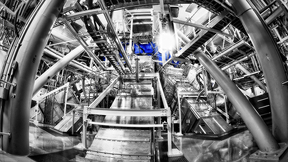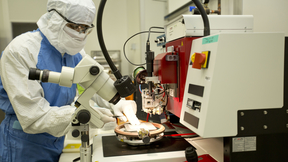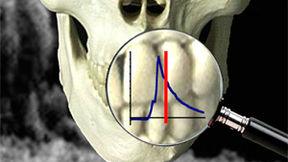Back
A multi-institutional team of scientists fired the 26th and final shot of the Pleiades experimental campaign at the National Ignition Facility last month. The campaign has created a new scientific foundation for the study of supersonic radiation flow in astrophysical phenomena and in inertial confinement fusion physics.Begun in 2011, the campaign was fielded by Los Alamos…
Livermore scientists are developing electrode array technology for monitoring brain activity as part of a collaborative research project with UC San Francisco to better understand how the neural circuitry of the brain works during memory retrieval.The long term goal of the research is a deeper understanding of the brain's memory processes so physicians can better treat…
LIVERMORE, Calif. - Lawrence Livermore National Laboratory recently received $5.6 million from the Department of Defense's Defense Advanced Research Projects Agency (DARPA) to develop an implantable neural interface with the ability to record and stimulate neurons within the brain for treating neuropsychiatric disorders.The technology will help doctors to better understand…
From developing the first accelerator mass spectrometer for use in the biology field to tracking radionuclides from the Dai-ichi Nuclear Power Plant disaster, the Laboratory's Center for Accelerator Mass Spectrometry (CAMS) has spent 25 years in the spotlight of not only dating ancient artifacts but solving global challenges.CAMS is celebrating its 25th anniversary this…
Research conducted at the Center for Accelerator Mass Spectrometry (CAMS) spans the universe, the depths of time and everything in between. Although not all elements and isotopes are able to be utilized by AMS, CAMS' researchers make the most of what nuclear physics has given them.Here is a sampling of some of the many ways CAMS is utilized, along with the important…
LIVERMORE, Calif. - L. Jeffrey (Jeff) Atherton has been named director of the National Ignition Facility (NIF) at Lawrence Livermore National Laboratory, Director Parney Albright announced Monday.Effective May 1, Atherton will take on the role of director as NIF, the world's largest and most energetic laser, transitions to a user facility. Ed Moses will remain the…
In a study published in a recent edition of Nano Letters , the Laboratory's Mike Malfatti, Heather Palko, Ed Kuhn and Ken Turteltaub report on accelerator mass spectrometry measurements used to investigate the relationship between administered dose, pharmacokinetics (PK), and long-term biodistribution of carbon 14-labeled silica nanopartocles in vivo .The increasing use of…
In an initiative that aims to boost the nation's economic competitiveness, Lawrence Livermore National Laboratory today announced the opening of the High Performance Computing Innovation Center (HPCIC).The innovation center will facilitate national lab/industry collaboration, applying high performance computing to product design, development and manufacturing, data…
In a large natural disaster, such as the Haitian earthquake earlier this year, or in an unsolved homicide case, knowing the birth date of an individual can guide forensic investigators to the correct identity among a large number of possible victims.Livermore researcher Bruce Buchholz and colleagues at the Karolinska Institute are looking at victims' teeth to determine how…












